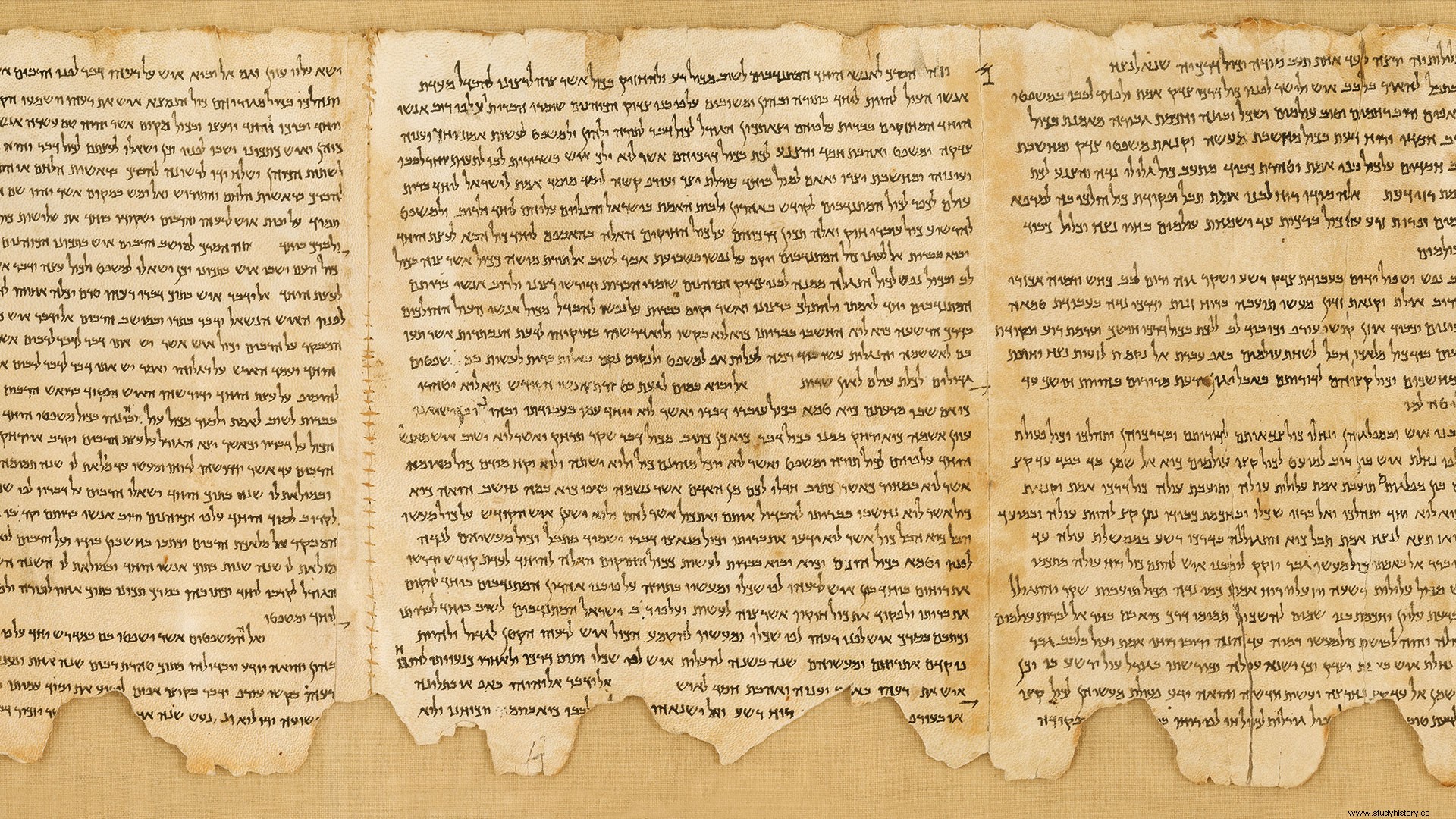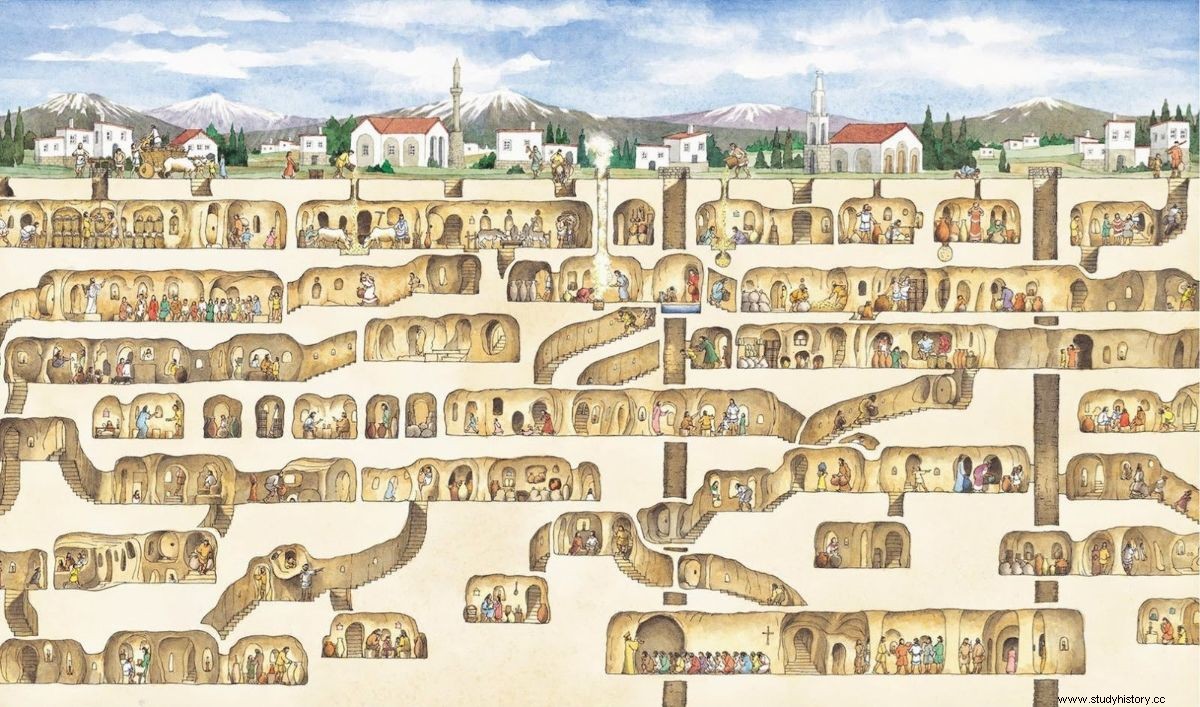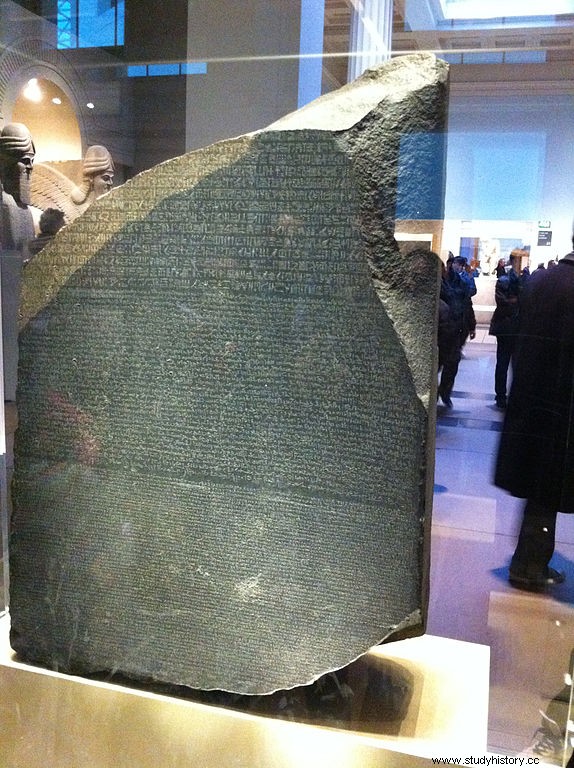Documentation of random findings is common, but how common are they?
For hundreds of years, there have been discoveries from all over the world. The majority of these have all been intentional. On the other hand, someone is by accident. The main reason is that archaeologists and historians know what to look for and its possible location. For the few who were found by accident, it was accidental luck.
The Dead Sea Scrolls

These ancient manuscripts are about 2 years old. Discovered between 000 and 1947, and dated between 1956. century BC. and 3rd century AD
Some pages are parchment, while others are papyrus.
The majority of the text is in Hebrew, the rest in Aramaic or Greek.
Found in the Desert Caves of Qumran, the warm desert climate and darkness of the caves preserved the scrolls.
Random discovery
In 1947, a Bedouin shepherd from the Ta'amireh tribe left his flock to find a wanderer. Around Qumran he found a cave in the gorge on a steep, rocky hillside. Through a rock inside he heard pots cracking. As he explored further, he discovered mysterious clay jars.
Many of the glasses were empty. The intact wore the lids. On closer inspection, it revealed old rolls inside the glasses, with some wrapped in linen and blackened by age.
With several scrolls found, the shepherd went to an antique dealer in Bethlehem. Accompanied by other tribesmen, they searched for several scrolls and found seven. Unaware of the value, the first antique dealer bought four. Another antique dealer, Salahi, bought three.
After hearing the news, the Hebrew professor Eliezar Lip Sukenik sat down to investigate.
Passing the Jerusalem border and the British divided military zone, he met an Armenian antiques dealer. Eager to see more of the ancient scripture, they traveled to meet Salahi. The professor was awe-inspiring to see the Hebrew manuscripts, 1 year older than anyone else he came across.
Excavation
From 1965, excavations took place after the news spread. In at least 12 caves there were several scroll fragments. Only a handful were intact. Researchers were able to put the fragments together, resulting in 950 manuscripts. The number of additions and deletions in the texts shows that the authors have freely modified what they copied.
Today, 100,000 fragments are in the Shrine of the Book , where the first seven rolls are. Now, located in the Israel Museum, Jerusalem, the scrolls are constantly being studied to discover their true origins.
Categories
After a thorough study process, researchers showed that the rolls fit into three different categories.
The first is biblical. The first 200 scrolls are now part of the Hebrew Bible, the earliest evidence of Bible text.
The second is apocryphal, works that are not included in Jewish texts and are incorrectly attributed to them. Large sections of the Jewish population valued them and seemed to reflect the faith of others.
The third is sectarian. A wide variety of genres, including biblical commentaries, religious-legal writings, liturgical texts, and apocalyptic contexts. It reflects the life of a particular community, believed to be the Essene community, one of the three most important Jewish sects.
By studying them, they show how diverse the religious belief system of ancient Judaism was.
Derinkuyu Underground City

A sub-territorial city, with homes and common facilities, built by early Christians to escape religious persecution. There are over eight levels. Rooms include food and beverage preparation areas, a church, mass warehouses, stables and wine presses.
Random discovery
In 1963, a Turkish man knocked down a wall in the basement and discovered a mysterious room. By digging further, he found a network of tunnels. This led to the discovery of the underground city, which led to excavation and preservation.
In 1969, almost half of the city became available after thorough excavation and restoration. Visitors can explore the sanctuary.
Formation
Located in Cappadocia (a region of Turkey), soft, volcanic rock is the foundation of the city. This is thanks to ancient volcanic eruptions. Over time, layers and layers of magma built up. Therefore, a stable rock formed that was able to cut about 60 meters (197 feet) below the surface. Furthermore, it protected nearly 200,000 people, including livestock.
The builders were Phrygians, an ancient Indo-European race, in the 7th and 8th centuries. Built and completed in the Byzantine era, during the Roman period, established Greek-speaking Christians Derinkuyu. The caves expanded to several levels.
A port
During the Arab-Byzantine Wars (780-1180), the inhabitants were protected from the Muslim Arabs.
In addition, Derinkuyu connected to other underground cities through a complex network of tunnels. The tunnels were created during the Arab-Byzantine War.
In the 14th century, it protected the Christians from the Mongols' attack on Timur.
In the 1920s, the underground city saved the Christians from persecution, during the Ottoman period, from the Turkish Muslim powers.
A well-preserved place that gives an insight into the lives of these "cave dwellers".
Lascaux Caves

This chance discovery is a Paleolithic cave in southwestern France, dating back to 17,000 - 15,000 BC
Random discovery
On September 12, 1940, four boys discovered a fox hole after following their dog. When they thought the hidden treasure was inside, they explored the hole. 15 meters (about 50 feet) below they found the cave paintings.
After getting out of the hole, the boys returned prepared. They started demanding entrance tickets for their friends to see the rescues.
News spread to their principal, a member of a local prehistoric community. Soon, Abbé Breuil (a prominent prehistorian) was informed of the cave and confirmed the authenticity of the paintings.
Excavation and analysis
There are about 600 paintings, mostly animals, on the inner walls. The paintings were not only a marvel, but the impressive composition of them in telling their stories. There were many horses, deer, aurochs, ibex, bison and some cats. In addition, there were mythical creatures and a human figure, a bird-headed man.
There is continuous speculation about the significance of the cave. It has a ritualistic, perhaps spiritual, aspect.
Homo sapiens made home in Europe, especially in southwestern France and northern Spain. It is possible that someone lived in the cave, the art served as a temporary activity.
Aftermath
The cave was opened to the public in the 1960s.
However, problems arose. First, it only harmed them by breathing on the paintings. Second, the thick atmosphere of the cave made visitors faint. Third, condensation on walls and ceilings led to excess moisture. As a result, the cave became infected with lichen and mold. Fourth, strong lighting increased the damage, causing the paintings to fade.
In 1963, the Lascaux Cave was closed to the public. The French Minister of Culture only allowed experts.
In 1979 it became a UNESCO World Heritage Site.
In 1983, for the public, experts created a copy of the cave. It is 200 meters from the original site in the village of Montignac.
The continuous effort to stop further damage brings more learning.
Rosetta stones

The Rosetta Stone is a broken piece of a larger slab, carved with a message from ancient Egypt.
The greatest significance of this accidental discovery is that it helped experts rediscover Egyptian hieroglyphs.
Random discovery
Between 1798 and 1801, Napoleon Bonaparte acted in Egypt. He aimed to dominate the eastern Mediterranean, and threatened the British grip on India.
The stories of finding the stone are vague.
Members of Napoleon's army repaired Fort Julien near the town of Rashid (Rosetta). They found the stone built into the wall. The engineering officer, Pierre François Xavier Bouchard, retrieved the stone from the wall. Later, the wall was destroyed as part of Fort Julien's construction.
General Menu, Bouchard's chief, noticed the significance of the stone. He sent it to Alexandria, where castings and copies were made. Shortly afterwards, it was seized by British General Tompkins Turner. After that, the stone took the trip to the British Museum in London.
Decryption of the Rosetta Stone
Many international researchers tried to decipher the code.
The Englishman Thomas Young discovered that hieroglyphs are related to an Egyptian ruler, Ptolemy V, and the direction the symbols are to be read.
However, a French scholar, Jean-François Champollion, suggests the text completely. Champollion discovered that the texts were in three different styles:ancient Egyptian hieroglyphs, ancient Egyptian demotic, and ancient Greek. What helped with the translation was his ability to read ancient Greek and Coptic.
The Coptic writing system is derived from the Greek alphabet. Many of the letters come from a daily Egyptian dialect.
Champollion found out what the demotic characters were in Coptic, which resulted in understanding their meaning. He then traces the demotic characters back to hieroglyphic symbols. Soon he was able to make educated guesses about what hieroglyphs stood for.
Jean-François Champollion became known as the founder of Egyptology.
Rosetta Stone is currently at the British Museum in London.
Three Ways Written
The first notable writing style was 14 lines of ancient Egyptian hieroglyphs, mainly used by priests for important or religious documents.
The other was 32 lines of ancient Egyptian demotics, used for daily use.
The third was 53 lines of ancient Greek. During that time, Greek was an administrative language. The rulers were Greek-Macedonian after the conquest of Alexander the Great.
Only priests, officials and rulers of ancient Egypt, written in all three, could read and understand it.
Decrypted history
In 196 BC. a group of Egyptian clergy and Ptolemy V issued a decree engraving the stone slab. From the translations, as clear evidence, Ptolemy V was a generous and religiously devoted leader. The priests in the temple in Memphis, Egypt, supported him.
The rediscovery of ancient Egyptian hieroglyphs reflects its significance.
Uluburun forlis

This is a Bronze Age ship, dated between 1330 - 1300 BC
It carried a full load of merchandise. The voyage, under speculation, was from a port in southern ancient Lydia, Turkey, with the destination as the Greek mainland.
Random discovery
In 1982, the Turkish sponge diver Mehmed Çakir came across what he described as "metal biscuits with ears". This was near the Mediterranean coast of Turkey, near Kaş. However, he discovered that they were more than they appeared.
After the news spread, a later discovery saw that it was an elite ship with cargo from the Bronze Age.
Between 1984 - 1994, the excavation took place over 11 seasons. 22,000 logged dives 45 meters (150 feet) below sea level.
The causes of the shipwreck are unknown.
The main theory lies in the location of the shipwreck. It was close to a high, rocky cliff that came out into the sea. There is reason to believe that strong, unexpected winds drove the ship to the rocks and caused it to sink.
Cargo
This is archaeological evidence of gifts exchanged by the wealthy. Luxury items included carved ivory containers and gold and semi-precious stones jewelry.
Copper and tin blocks, along with empty and food-filled pottery, were also at Uluburun.
In addition, there were raw materials from distant lands:glass blocks, unprocessed elephant tusks, ostrich eggshells and faience pearls.
Weapons on board suggest possible piracy threats.
Among the personal items were balance weights and musical instruments. This suggests that a crew from Syro-Cannanite and several Greek passengers were on board.
As an undisturbed time capsule, it provides a glimpse into the Bronze Age, especially in trade and materialism. In addition, aspects of construction, economic exchange and transport were part of the discovery.
Venus De Milo

Also known as Aphrodite of Milos , this Parisian marble sculpture was by Alexandros of Antioch in the 2nd century BC
Random discovery
There are several interpretations of this part of the story. While plowing the field or looking for building blocks, Yorgos Kentrotas found a small cave near a farmer's plot. Another version says that Yorgos' son, Antonios, was with him when the cave was found. Inside the rescue as the upper half of a marble statue of a woman. The search began for the lower half.
The French navy's ensign, Olivier Voutier, anchored his ship on the island, Milos. He sought out antiques. He met a man (and his son) who was searching through the rocks near the Greek village of Trypiti. After seeing that they found a half marble statue, he began to help find the other half and the pieces.
After reporting to their supervisors, the French bought both halves of the statue. Shortly afterwards it was called Venus de Milo .
The statue arrived in France a year later and was presented to Louis XVIII. He later donated the statue to the Louvre.
According to reports, the statue was found with several columns decorated with marble heads. In addition, fragments of an upper left arm containing an apple were found. An inscribed plinth, believed to be part of the marble statue, was lost during transport after it was discovered.
Analysis
According to the Louvre, the sculpture is of two marble blocks:one for the upper part of the body and the other for the lower half. There is speculation about the color and jewelry of the statue.
The sculpture can be one of two gods:
- Venus, the Roman goddess of love, because of the nudity and curve of the body, or
- Amphitheater, Greek goddess from the sea. Milos is known as her place of worship.
The biggest mystery of this accidental discovery is the location of her arms.
For many artists, Venus de Milo is the symbol of graceful, feminine beauty.
Xian Terra Cotta Warriors

Lifestyle and detailed statues representing the guards of the first emperor of China, Qin Shi Huang. The purpose was to follow China's first emperor in the afterlife, and to protect him spiritually.
Construction began in 246 BC. and ended in 206 BC, years after the death of the first emperor.
It took about 40 years to complete, with over 72,000 workers.
Random discovery
In 1974, there was a drought in several areas of China. Farmers, desperate for water, dug a well. One meter into the ground, they hit red soil. They found large ceramic heads and several bronze arrowheads.
Archaeologist Zhou Kangmin, who was aware of the discovery, started the excavation.
Excavation
A deep excavation discovered 600 pits, complex underground vaults. Although some are difficult to access, three large pits are easily accessible.
Mine 1 is the largest with 6 soldiers and horses. However, only 000 are on display.
The soldiers and horses face east in a rectangular formation, armed with a long spear, dagger or halberd. The vanguard (leading the advance) is three rows of infantry just east of the formation. Behind them is the main force of armored soldiers, with weapons and eight horse-drawn carriages. North, south and west of the formation is the army's defense wing.
Pit 2 reveals the mystery of ancient army formation. There are four devices:
- First unit:kneeling and standing soldiers.
- Second unit:chariots in war arrangements.
- Third unit:infantry, chariots and troops in a rectangular formation.
- Fourth unit:many troops using weapons.
Pit 3 is the command post, the smallest pit. 68 terracotta figures are in command, many headless and speculated to be official figures.
Create Army
Clay was a cheaper alternative to form the huge army.
Made on an assembly line, pieces of each warrior were created separately.
First, separate shapes were added to the surface of the sculptures. Then artists would individually model faces and hair. Then, after being placed in kilns, the sculptures were hard and durable. Eventually they were painted, each figure became different and unique.
However, due to moisture and erosion for 2 years, the Terra Cotta Army has lost its color.
Nevertheless, they provide a glimpse into the military, cultural and economic history of the past.
Cultural significance in anthropology

It is through the findings of the past that we are able to understand the history of the world. These random discoveries are more than just accidents. They show that there is more to learn about the world, about different cultures and societies. From learning about rulers to understanding methods of protection, there are endless possibilities for what the gaps in history are. It may not be an archaeologist or historian who finds the next piece of history. It can only be in the right place at the right time.
- There are no accidents. It is just a purpose that we have not yet understood. ”
- Deepak Chopra.
